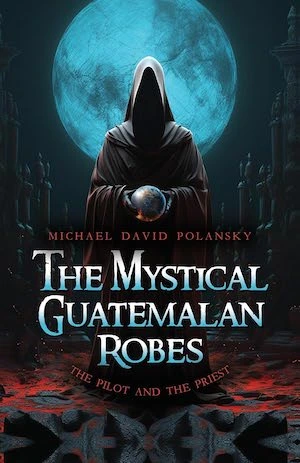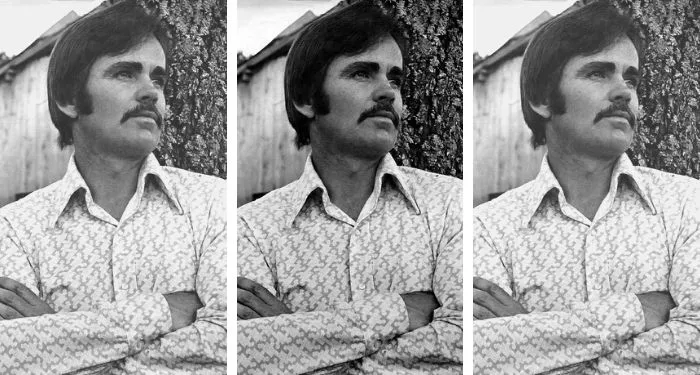The Mystical Guatemalan Robes: The Pilot and the Priest by Michael Polansky
“Seeing the places where ancient Mayans lived, then suddenly disappeared, ripened my appetite for the local folklore that was in generous supply … At night, I can still hear the cries of anxious monks and fallen conquistadors roaming the cobblestone streets of Antigua.”
With this captivating tidbit, author Michael Polansky unveils the inspiration behind his world of folklore, mysticism and horror in The Mystical Guatemalan Robes. This mind-bending tale stretches across centuries to intertwine the lives of two men — an airline pilot and a sixteenth-century monk who, despite their innumerable differences, share a tragic and ghastly past. The novel examines immortality, human nature and the ways trauma can unravel our very selves, all while pulling the reader into a dizzying world of magic and science, threaded together in fabric that can be wielded for good or ill.
In this Q&A, Polansky shares his thoughts on morally complex main characters, bringing reality’s horrors into fiction and what defines a hero — even a complicated one — versus a villain.
Q: Where did the idea for The Mystical Guatemalan Robes come from?
A: My life as an international airline pilot was like living between Indiana Jones and Anthony Bourdain. My curious, adventurous nature led me to indigenous people in exotic locations, where their stories and struggles became the fuel for my imagination. The indigenous people of the world, through conveyances of folklore, created many of the characters and themes in my first book.
My 92-year-old English teacher in the eleventh grade looked at me one day and said, “Someday you’re going to write a book.” She winked, which gave the moment a sincerity that I have carried on my shoulders for over 60 years. Sharing the exhilaration of my travels and adventures closes the loop on a goal I have had since the eleventh grade.
Q: The concept of immortality often explores both its allure and its curse. How does the monk’s immortality shape his moral and psychological journey throughout the centuries?
A: A victim of sexual abuse as a youth, the monk seeks refuge in religion, only to find that his isolation intensifies his anger and amplifies his thirst for revenge. He knows that his sins could jeopardize his ascent into eternal life. He is an easy target for a secretive sect of robed beings in Guatemala, offering immortality in return for the services only he can provide. His new power in place, the monk engages in senseless, brutal acts against children. Over time, the monk begins to see that an eternal quest for an insatiable redemption lacks the closure his spirit requires. He discovers that immortality and eternal life are not the same thing.
Q: The dynamic between the monk and the airline pilot suggests a deeply intertwined fate. How did you develop this connection, and what does their shared past reveal about the nature of their conflict?
A: Learning about sexual abuse in the church at an early age left an indelible impression on my persona. Every month seems to bring new accusations of sexual abuse against children, and they have probably persisted for hundreds if not thousands of years. As victims of childhood sexual abuse, both pilot and priest rose from my imagination with the folklore of Guatemala as a backdrop. The way each character deals with their trauma may have more to do with the ability to forgive than it does to forget. Burying trauma allows it to smolder in our subconscious while slowly poisoning our thinking. Forgiveness comes with the resolution of inner conflict and the retrieval of self-control.
Q: Guatemala’s rich cultural and spiritual history plays a central role in your novel. How did you research the robed sect and the highland setting, and how does this specific locale influence the mystical elements of the story?
A: Research for The Mystical Guatemalan Robes was accomplished with boots on the ground. On layovers in Guatemala City, I would frequently venture up into the central and southwestern highlands in search of unique food and contact with the indigenous people of the area. Seeing the places where ancient Mayans lived, then suddenly disappeared, ripened my appetite for the local folklore that was in generous supply. The priest’s mysterious sect had an unusual interest in our planet’s volcanic activity and their demand for secrecy would make the highlands a perfect spot for a research facility. At night, I can still hear the cries of anxious monks and fallen conquistadors roaming the cobblestone streets of Antigua.
Q: The novel confronts themes of trauma, both from the monk’s past actions and the pilot’s PTSD. How do these forms of suffering shape their motivations and the ultimate confrontation?
A: The era in which the pilot and the priest incurred their trauma plays a large role in determining their behavior. Hundreds of years ago, the stigma of sexual abuse would probably have been treated with denial and the desire to avoid public scrutiny. Help for the victim would be in short supply as society was more conservative. It is both ironic and logical that some victims would turn to the church for redemption. Contemporary society is more open and educated in dealing with sexual abuse, even though social stigma for the victim still exists.
Q: The robe appears to be a symbol of immense power in the story. Can you discuss the significance of the robe, both as a physical object and as a metaphor for the characters’ internal struggles?
A: Simply put, the robe is a device created by a scientifically advanced civilization. Its purpose is to compensate for perceived weaknesses in members of its society. It can provide transportation and impenetrable protection, in addition to amplifying its user’s strength. All four forms of matter (gas, liquid, solid and plasma) are used in the fabrication of each robe, making it incomprehensible to our primitive understanding of science. The only person outside of the priest’s circle to have donned a robe, the pilot, is convinced that it holds the secret to the power and nature of the mysterious sect in Guatemala. Symbolically, the robe could be the bridge to defeating a seemingly invincible enemy.
Q: By portraying a pedophile monk as one of your central characters, you tackle a controversial figure. What challenges did you face in developing his character while balancing the moral complexities of his actions and redemption, if any?
A: I struggled with creating an evil character for fear that I might be viewed as compromising my own values and beliefs. Focusing on the criminal and psychological issues surrounding pedophilia and the trauma it produces kept me focused on the victims and not the explicit details of their plight. As an author, I feel I have the responsibility to avoid sensationalizing inappropriate, salacious behavior. The priest is a troubled character who realizes that he is beyond redemption, and yet, a pilot appears who sounds more like a saint than a soldier. The impact of the pilot’s conversations and battles with the priest expose the inner workings of each character in a sensitive and dignified manner.
Q: The idea of a holy war between two deeply flawed characters raises questions about the nature of good and evil. How does the novel challenge traditional notions of heroism and villainy in this high-stakes battle for humanity’s fate?
A: Villains allow their flaws to define their behavior, whereas heroes defy their shortcomings in making decisions. The priest is driven by instinct, the pilot by critical thinking. Twenty-five-hundred years ago, Socrates tried to tell the world that critical thinking is the glue that holds organized society together. It is what we think that drives all productive behavior. You can’t touch or see thought, yet its power is irrefutable. As a pilot, I became aware of the importance of critical thinking in staying alive. The broader implications for humanity in thinking critically are staggering. The Mysterious Guatemalan Robes is a serious exploration of critical thinking and its power to save humanity or suffer the consequences of arrogant neglect.

Publish Date: February 28, 2024
Genre: Fantasy
Author: Michael Polansky
Page Count: 472 pages
ISBN: 9798989291502



















 English (US) ·
English (US) ·